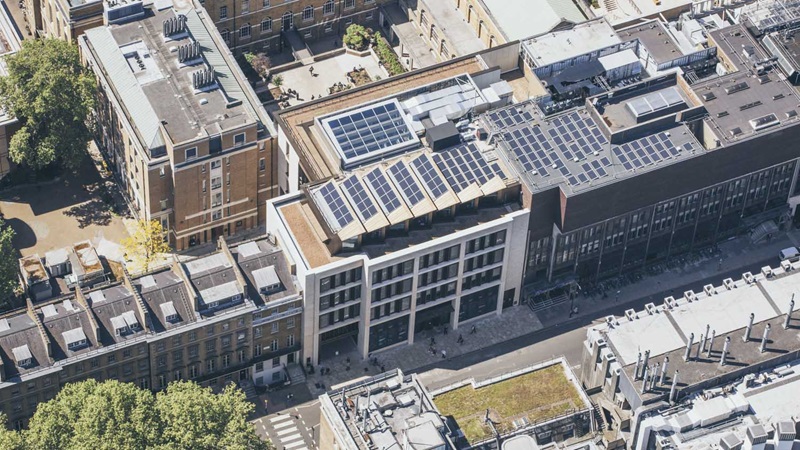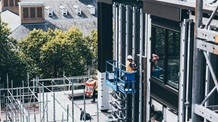The key to higher education's sustainable future
As the green shoots of recovery start to emerge following the pandemic, decision makers in the higher education sector can now take a step back from reactive measures, and once again set their sights on the bigger picture.
The Association of University Directors of Estates (AUDE) recently published its annual Estates Management Report (EMR), which is one of the leading publications for UK universities looking to make strategic long-term decisions about their estates. Following the challenges of the last two years - with most student learning moving to digital and hybrid models - this year’s report inevitably focused on Covid recovery. However, the report also draws attention to another matter of utmost urgency - the need to prioritise sustainability and green credentials, as we plan for the future of the sector. These needs grow ever more pressing by the day – and inaction is no longer an option.
In November last year, COP26 served as a powerful reminder that sustainability should remain high on everyone’s agenda, and the AUDE report has come at a crucial time to substantiate this.
The need for robust and ambitious carbon reductions has never been greater, with both public and policy pressures now shaping student expectation. As a result, estate directors should be more focused than ever on embedding sustainability into future developments.
For students, there is an ever-increasing focus on satisfaction, health, wellness and productivity. This has led to a more collaborative way of planning for and providing high performance estates - and is only set to increase as technology permits more monitoring and modelling of what really works. It is no longer enough to build world-class, state-of-the-art spaces. We must build world-leading, trailblazing facilities that cut carbon, reduce emissions, and help drive toward net zero – and in doing so, attract students whose minds will be key in unlocking a greener future.
Now is the time for higher education to capitalise on innovation and tackle challenges head on. But what’s the best route to the securing the sector’s sustainable future?
From offsetting to cutting emissions
The construction sector plays a crucial role in reducing carbon emissions – both directly and indirectly. The emissions are graded as Scope 1, 2 and 3; with Scope 1 classed as all direct emissions, Scope 2 as indirect emissions (for example, energy purchased) and Scope 3 as all other indirect emissions. If we can address scope 1 and 2, we will significantly reduce a building’s footprint and in the long-term, influence a reduction in Scope 3 emissions.
To do this, we must first ensure the simple application of the basics. The starting point is decarbonising our systems and adapting the materials we use, looking for more sustainable alternatives and addressing the embodied carbon of the construction process. By moving away from fossil fuels, both for the construction of the buildings and for when the sites are open and operational, we can source more renewable alternatives.
With rising energy prices across the world, addressing the overall energy consumption and wastage of our buildings by using technology and innovative solutions, will help futureproof estates for decades to come. We must also be more innovative with the way we design our buildings, adapting them to future ways of working. Students are now less interested in studying in large lecture theatres but instead looking for collaborative communal workspaces that inspire and incorporate sustainable solutions. Recent developments like the LSE Marshall Building are testament to this - not only a feat of engineering and design but one that also used sustainably produced concrete, with ground granulated blast furnace slag (GGBS) used to reduce the cement content, and concrete volumes reduced through extensive post-tensioning, overall saving 12,000 tonnes of carbon.
Modern Methods of Construction (MMC)
Off-site and pre-manufacturing will also play a significant role in reducing carbon. Mace is creating specific building typologies that are 85% manufactured off-site, factory safe, and factory quality -accelerating our move to a manufactured construction industry. By moving towards this, overall project delivery speed can be significantly improved, we can realise net zero benefits, give a building a safety guarantee, and enable improved digital compatibility.
Our work with University College London’s Student Centre is a great example of a multi-faceted project that was able to embrace MMC. We helped transform outdated interior spaces into state-of-the-art teaching facilities by standardising the installation and maintenance of building-wide fixtures and fittings. By developing the radiator-boxing requirement from a multiple-trade process to a single-sourced prefabricated product, it reduced the timings in the programme and provided cost savings – closing the gap between research and industry, working with scientists and supply chain partners and delivering carbon reduction plans across the entire life cycle.
Data-driven solutions
The construction industry has already made great strides in sharing lessons, developing new technologies and finding new solutions to tackle the climate emergency. But more must be done.
By using data driven net zero carbon design, we can integrate technology to measure and modify the future carbon footprint of a building. Modelling scenarios means we will better understand how the building will perform, and in turn put forward the best solutions that will drive efficiencies in the future.
Mace’s work at the University of Birmingham’s School of Engineering is demonstrative of the impact data driven solutions can have. The project was awarded a BREEAM ‘Outstanding’ certification, and an A rated Energy Performance Certificate, achieving the highest levels of sustainability performance without significant impact on budget or programme.
Proactive planning
Starting with the proper application of the basics now, we can create an environment for further innovation, making room for the solutions that will help to achieve the sector’s net zero ambitions. While the pandemic has proved a challenge for the higher education, estate directors now find themselves at another crucial juncture, as we move away from reacting to the impact of Covid, to proactively planning for a more sustainable future. But we cannot simply do less of everything - we have to find new ways of thinking and work hand in hand with emerging technology to enable swift action. And as the AUDE report confirms, that action must not only be swift, but immediate.












